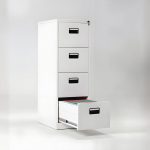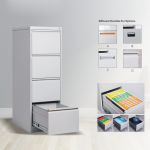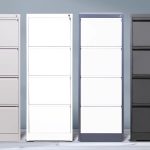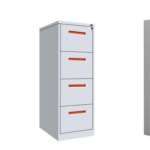Is your office drowning in paperwork? A 2023 study by the National Association of Professional Organizers found that 68% of small businesses lose at least 2 hours per week searching for misplaced files. The solution? A 4 drawer file cabinet—the unsung hero of office productivity.
Unlike cramped 2 drawer models or bulky 5+ drawer behemoths, a well-designed 4 drawer file cabinet offers the perfect balance: enough capacity for a 5-10 person team while fitting under standard desks (52-55" height). Let’s dive into how to choose, organize, and optimize this essential tool.
Why Choose a 4 Drawer File Cabinet Over Other Sizes?
When comparing storage options, the 4 drawer design stands out for three key reasons:
1. Flexible File Organization
2 drawer file cabinets force you to mix active projects with archived files, leading to clutter.
5+ drawer cabinets often require complex labeling systems to manage the extra compartments.
4 drawer solution:
- Top 2 drawers: Daily/weekly access (e.g., client contracts, invoices)
- Bottom 2 drawers: Monthly/quarterly access (e.g., tax records, employee files)
Pro Tip: Use color-coded hanging folders (e.g., red for urgent, blue for archived) to cut search time.
2. Space-Efficient Design
A typical 4-drawer steel cabinet (24" W x 18" D x 52" H) occupies just 3.6 sq. ft. of floor space—equivalent to a single office chair. Compare this to a 5 drawer model (same width but 65" tall), which blocks natural light and creates a cramped feel.
3. Cost-Per-Drawer Advantage
| Cabinet Type | Average Cost | Cost Per Drawer |
|---|---|---|
| 2 Drawer | 150–250 | 75–125 |
| 4 Drawer | 280–450 | 70–112 |
| 5 Drawer | 400–600 | 80–120 |
Data source: Office Furniture Market Report 2024
7 Critical Features to Evaluate Before Buying
1. Drawer Configuration: Not All Designs Are Equal
Avoid cabinets with four equal-depth drawers (typically 10-12" deep). These force you to stack files vertically, causing papers to slump and jam the slides.
Optimal layout:
- 2 full-width drawers (12-14" deep) for hanging letter/legal folders
- 2 half-width drawers (6-7" deep) for storage boxes, pens, or laptops
2. Slide Mechanism: The Silent Killer of Productivity
Cheap cabinets use 12-gauge steel slides that sag under load, making drawers stick or fall off tracks. Look for:
- 20-gauge steel slides (rated for 80+ lbs per drawer)
- Ball-bearing mechanism (smoother operation than roller slides)
- Full-extension slides (allow 100% drawer access vs. 75% on partial-extension models)
Test method: Open the drawer fully and place a 50-lb weight (e.g., a case of printer paper) inside. If the front sags more than 1/4", skip this model.
3. Locking System: Security Without Complexity
| Lock Type | Best For | Pros | Cons |
|---|---|---|---|
| Central lock | General offices | One key controls all drawers | Lost key = full cabinet access |
| Independent locks | Legal/medical offices | Each drawer locks separately | More keys to manage |
| Electronic keypad | High-security environments | No physical keys, audit trail | Requires battery replacement |
Pro Tip: For HIPAA-compliant medical offices, choose a cabinet with ANSI/BHMA Grade 1 locks (resistant to 30-minute forced entry).
4. Anti-Tip Design: A Non-Negotiable Safety Feature
Every year, 12,000+ tip-over accidents occur from unsecured furniture (CPSC data). Ensure your cabinet has:
- Wall anchor kit (included with reputable brands like Lorell)
- Interlocking drawers (only one drawer opens at a time)
- Wide base (≥22" depth for stability)
5. Material Durability: Steel vs. Wood vs. Plastic
| Material | Lifespan | Fire Rating | Best Use Case |
|---|---|---|---|
| Cold-rolled steel | 15+ years | UL Class 350 (1-hour) | High-traffic offices |
| Engineered wood | 8–10 years | None | Home offices (aesthetic focus) |
| High-density plastic | 5–7 years | None | Damp environments (e.g., basements) |
Warning: Avoid "particleboard" cabinets labeled as "wood"—they swell and disintegrate within 2 years of spills.
6. Environmental Certifications
Look for GREENGUARD Gold certification, which ensures甲醛 (formaldehyde) emissions are ≤0.05 ppm—safe for enclosed spaces like medical offices.
7. Expandability: Future-Proof Your Investment
Top-rated cabinets offer modular accessories:
- Printer tray (turns the top into a mini workstation)
- Cable management (routes power cords for desktop devices)
- Drawer dividers (customizes compartments for non-file items)
FAQ: Your Top 5 Questions Answered
Q1: Will a 4-drawer file cabinet fit under my desk?
Most models (52" H x 24" W) slide under 29–30" high desks, but measure your knee clearance first—some desks have aprons that reduce usable height.
Q2: How heavy is a fully loaded steel 4-drawer cabinet?
Empty weight: 150–200 lbs
With files (400 sheets/drawer): 350–450 lbs
Safety Tip: Place on a reinforced floor or use furniture glides to distribute weight.
Q3: What’s the best way to organize files for quick retrieval?
Use the 3-2-1 system:
- 3 active drawers: Sorted by priority (e.g., "Due this week," "Due this month," "Long-term projects")
- 2 reference drawers: By category (e.g., "Vendor contracts," "Employee manuals")
- 1 archive drawer: By year (oldest files at the back)
Q4: Can I stack two 2-drawer cabinets instead of buying a 4-drawer unit?
While possible, dedicated 4-drawer units offer better stability, integrated locking systems, and more consistent operation.
Q5: What's the difference between letter-size and legal-size cabinets?
Legal-size cabinets are approximately 5 inches deeper to accommodate longer files. Choose based on your document requirements.





